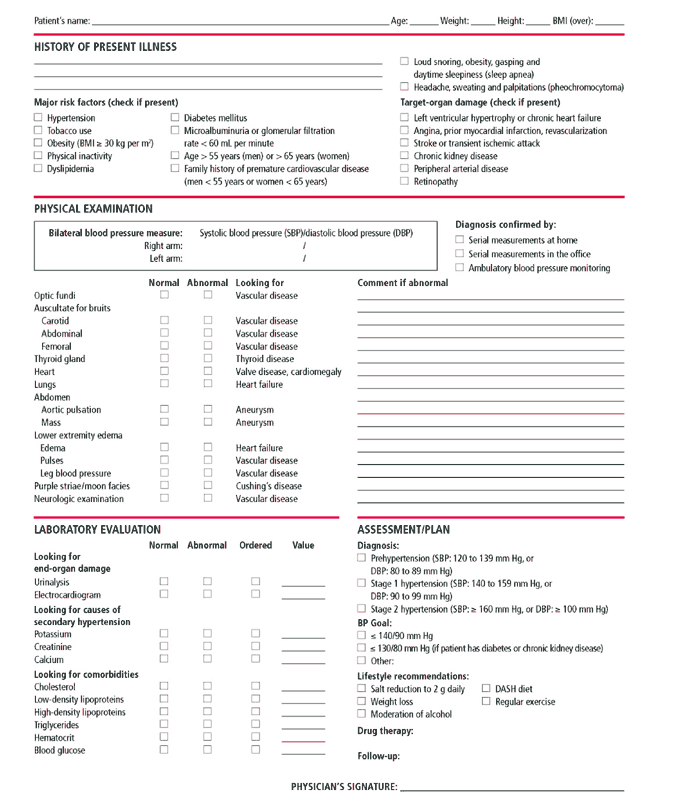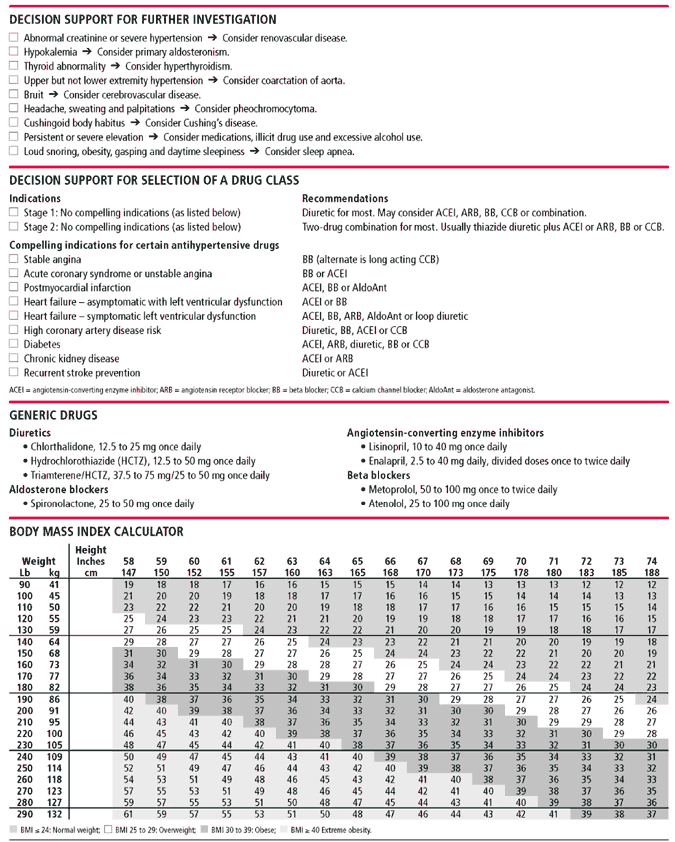
This evidence-based encounter form will assist you in providing care consistent with the latest hypertension guidelines.
Fam Pract Manag. 2004;11(3):79
Evidence-based clinical guidelines can help synthesize the vast research on a clinical topic and summarize care recommendations. However, guidelines alone are often insufficient to change physician behavior at the point of care. Care reminders and decision support tools are needed to help physicians put the guidelines into practice and, thus, improve patient outcomes.
The Joint National Committee on Prevention, Detection, Evaluation and Treatment of High Blood Pressure recently released its seventh report (JNC 7).1 This guideline takes a largely evidence-based approach to the development of recommendations. Key changes include the addition of a new “prehypertension” category, revised recommendations for patients with important comorbidities (i.e., “compelling indications”), and the recognition that most patients will need at least two drugs to control their hypertension. (To read an executive summary of the guidelines, visit http://www.nhlbi.nih.gov/guidelines/hypertension/express.pdf.)
POINT-OF-CARE SERIES
This article is part of a series that offers evidence-based tools to assist family physicians in improving their decision making at the point of care. The series is produced in partnership with American Family Physician. A related article, which includes the same hypertension encounterform, appears in the March 15, 2004, issue of AFP, pages 1485-1487.
Other articles in this series include “Making Decisions at the Point of Care: Sore Throat,” FPM, September 2003, page 68, and "Diagnosing Pulmonary Embolism." FPM, February 2004, page 61.
The JNC 7 provides a two-page quick-reference card (http://www.nhlbi.nih.gov/guidelines/hypertension/phycard.pdf) intended to help physicians remember and follow the hypertension guidelines at the point of care. This article takes that card one step further by presenting a two-page evidence-based encounter form for the initial evaluation of a patient with hypertension. It begins with an assessment of cardiovascular risk factors and a survey to remind the physician to look for target organ damage. The directed physical examination also focuses on possible causes of secondary hypertension, such as renovascular disease and Cushing’s disease, and on target organ damage, such as peripheral arterial disease.
A directed laboratory evaluation completes the survey for target organ damage and the initial evaluation for secondary hypertension. Note that JNC 7 recommends more invasive testing for secondary causes of hypertension only if the patient’s hypertension is difficult to control. Finally, the encounter form reminds physicians to recommend lifestyle changes, lists target blood pressures, and provides a place for physicians to record their initial choice of drug therapy (if any) and their recommendations for follow-up.
The encounter form provides several decision-support tools:
A list of secondary causes of hypertension and comorbidities,
A table to guide initial drug selection, based on comorbidities,
A reminder about dosing generic drugs,
A table for quickly determining the patient’s body mass index (BMI).
Use of this encounter form should make it easier for physicians to provide care consistent with the JNC 7 guideline, resulting in improved outcomes for our patients.
Hypertension Encounter Form


Encounter form developed by Mark H. Ebell, MD, MS. Copyright (c) 2004 American Academy of Family Physicians. Physicians may photocopy or adapt for use in their own practices; all other rights reserved. "A Tool for Evaluating Hypertension." Ebell MH. Family Practice Management. March 2004:79-81; https://www.aafp.org/fpm/20040300/79atoo.html.